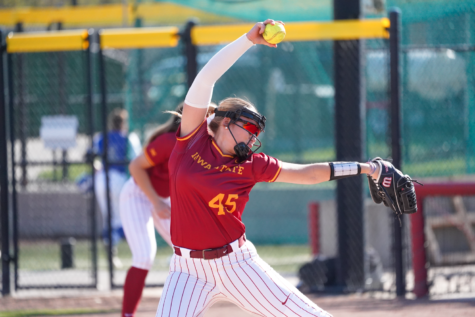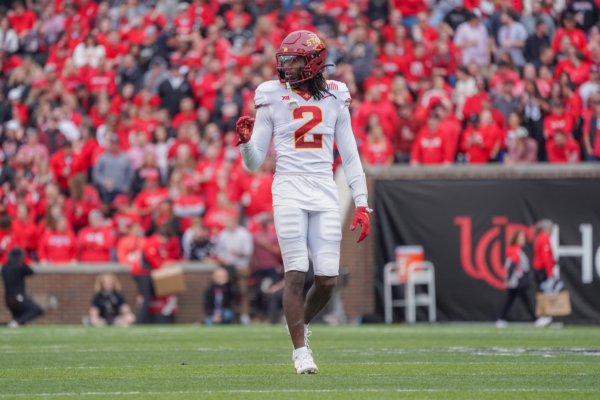My connection with baseball history
July 12, 2001
A man in a suit carries a leather bag into the Bob Feller Museum. The Louisville Slugger insignia brushes against his slacks.
He sets it behind the podium. Unzips. Takes out a bat.
Green velvet engulfs everything but the knob of the bat. Fitting here in Van Meter. Every piece of baseball lore is encased behind glass or plastic.
Now, Hall-of-Fame pitcher Bob Feller stands before the microphones and podium. He pulls the velvet sheaf off.
People crowd around, inch still closer to Feller. Video cameras whir. Still cameras flash.
He says, “Babe Ruth” “signed right there.” Flash. Flash.
Flash.
Many pictures were taken June 13, 1948. Let’s look at Nat Fein’s of the New York Herald Tribune.
His won the Pulitzer later that year.
It is the 25th Anniversary of “The House that Ruth Built.” Babe Ruth stands in the foreground with his back turned to Fein’s camera, in full uniform.
Ravaged by throat cancer, he is limp and feeble.
In the background, thousands of rows of eyes at Yankee Stadium remember him as young and powerful.
Flanked on Ruth’s right, along the first-base line, are the current Yankees. None look at him. Maybe they’re suddenly aware of their own fatality; their own ballplaying lifestyles.
Ruth’s cap is doffed. It hangs from the hand he used to throw fastballs with a generation ago.
Babe is 53 years old. Today is the last time anyone will see him in jersey and pants and cleats. He will die of cancer two months and three days from now.
Because of his condition, he needed something to support himself when standing before the crowd.
That’s Feller’s bat Ruth is leaning on.
Flash.
Feller is holding the bat and telling the story again – the fourth time this hour.
Feller was pitching that day for the Indians. As Ruth walked up the Cleveland dugout, Feller’s teammate Eddie Robinson handed Ruth the bat.
When Ruth finished waving and mouthing thank you, he signed it.
His scrawl is barely visible. Flash. I’m not the only one wanting a look.
The bat is the color of a dark tan received by an everlasting summer.
I step back so the 50 or so people behind me can quit craning their necks over the press to see.
Feller says the Indians hid the bat so no one could swing at the plate with it.
“If someone uses that bat, somebody might call the sheriff,” Feller says, reminiscing.
Barry Halper, a collector of memorabilia, eventually bought it.
Halper sold it to Upper Deck Company more than 50 years later for a reported $107,000.
Feller says the trading card company ran a gimmick – find the right card, get Babe’s bat.
Larry May, a retired truck driver from Seattle, found the right card.
He also found a reported $35,000 worth of taxes on the bat after Uncle Sam discovered it was worth the aforementioned $107,000.
Feller says his lawyer, Indian manager Ted Hargrove, former commissioner Faye Vincent and people from Cooperstown helped buy Feller the bat.
Feller won’t disclose details, but says it was a little less than what Upper Deck paid for it.
Tuesday was the first day the bat spends in Feller’s Museum. In a year or so, it heads to Cooperstown.
Now Feller monotones on about his career (18 years with the Indians, 266 career wins).
I quit writing and take a look around. Taped to the off-white wall is a piece of paper with black print: NO FLASH PHOTOGRAPHY OR VIDEO CAMERAS PLEASE. Oops.
There’s Feller posing with George Bush as president. There’s Feller posing with Ronald Reagan as actor.
Feller with DiMaggio.
Feller with Williams. “Ted Williams is the greatest hitter that ever-lived,” the 82-year old says.
The subject has switched.
Maybe so, but my eyes keep returning to the bronze bat. Babe Ruth held that. In fact, it was the last he ever held in his “house.”
I leave the museum, which is actually a small one-story house (as evidenced by the grandfather clock I was writing next to).
I walk halfway to my car, full with July air, and turn around.
I find Feller in an adjacent room. He is riding a current of conversation. I separate it. Ask him if I can hold the bat.
He hands it over.
I’ve never heard Babe play on the radio. Never read about him the morning after in the papers. Never seen him in person.
But when I wag the 35 inch, 30 ounces that Babe never parked a curveball with, I tingle.
And just for a flash-frame of a second, I’m connected with history.
Paul Kix is a junior in journalism and mass communication from Hubbard.
















